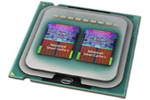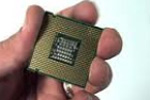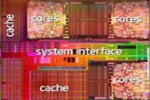Computing |
|
Informatika |
The multi-core architecture

|
|
Višejezgrena arhitektura

|
Utilizing the multi-core architectures

|
|
Iskorištavanje višejezgrenih arhitektura

|
Clock speed, optimization of the execution flow and cache memory

|
|
Radni takt, optimizacija toka izvršavanja programa i priručna memorija

|
Concurrent programming

|
|
Paralelno programiranje

|
Open specification for multi processing (OpenMP)

|
|
Otvorena specifikacija za višeprocesorski rad (OpenMP)

|
Advantages of OpenMP

|
|
Prednosti OpenMP-a

|
The future of multi-core designs

|
|
Budućnost višejezgrenih dizajna

|
Conclusion

|
|
Zaključak

|
|
|
|
|

The multi-core architecture
Multi-core processors are formed as a result of combining two or more solo cores into a unit comprising a single integrated circuit.
Multi-core processors came into being since improving performance by increasing the clock speed had reached its physical limitations.
Also, the cost of producing a single powerful core proved to be really expensive.
We could actually build slightly faster single-core chips, but it would cost twice while gaining only a 20 percent speed increase.
Current transistor technology prohibits any more increase in the clock speed.
As transistor gets smaller, this problem gets highlighted more and more.
The gate which switches the electricity on and off gets thinner and less able to block the flow of electrons.
Thus, small transistors tend to use electricity all the time, even when they aren't switching states.
This wastes power...

|
|

Višejezgrena arhitektura
Višejezgreni procesori dobivaju se spajanjem dvije ili više pojedinačnih jezgri u jednu cjelinu koja sačinjava integrirani krug.
Višejezgreni procesori nastali su kao posljedica činjenice da je poboljšanje performansi povećanjem takta dosegnulo svoja fizička ograničenja.
Također, cijena proizvodnje jedne snažne jezgre pokazala se vrlo visokom.
Zapravo bismo i mogli izraditi malo brže jednojezgrene čipove, ali bi im cijena bila dva puta viša, dok bi povećanje brzine iznosilo samo 20 posto.
Trenutačna tehnologija izrade tranzistora onemogućava bilo kakvo dodatno povećanje takta.
Kako se tranzistori sve više smanjuju, ovaj problem postaje sve izraženiji.
Sklop koji uključuje i isključuje struju postaje sve tanji i manje sposoban blokirati protok elektrona.
Dakle, mali tranzistori imaju tendenciju trošiti struju cijelo vrijeme, čak i kada ne prebacuju stanja.
Time se uzalud troši električna energija...

|

Utilizing the multi-core architectures
The traditional way of programming will not efficiently take advantage of multi-core systems.
In order to fully exploit these multi-core machines, organizations need to redesign applications so that the processors can treat them as multiple threads of execution.
Programmers need to hunt for optimum spots in their codes to insert the parallel code, divide the work approximately into equal parts that can be run simultaneously and adjust times for the communication of the threads.
If we want our programs to run faster, we must learn to write parallel programs.
Therefore, software developers must take steps to modify the traditional way of writing programs...

|
|

Iskorištavanje višejezgrenih arhitektura
Tradicionalan način programiranja neće učinkovito iskoristiti višejezgrene sustave.
Da bi u potpunosti mogle iskoristiti ove višejezgrene strojeve, tvrtke trebaju redizajnirati aplikacije kako bi ih procesori mogli tretirati kao višestruke niti izvršavanja.
Programeri trebaju tražiti optimalna mjesta u svojim programskim kodovima kako bi umetnuli paralelni kod, podijelili posao na otprilike jednake dijelove koji se mogu izvoditi istodobno i prilagodili vremenske periode za komunikaciju između programskih niti.
Ako želimo da naši programi rade brže, moramo naučiti pisati paralelne programe.
Stoga programeri softvera moraju poduzeti korake kako bi izmijenili tradicionalan način pisanja programa...

|

Clock speed, optimization of the execution flow and cache memory
Clock speed basically means the speed of the computer.
However, the practice of increasing the clock speeds of computers to increase their overall efficiency is slowly becoming an antiquated concept.
Clock speeds have hit a wall in recent years.
Increasing the clock speed beyond 4 GHz has serious consequences such as increased heat production, high power consumption and current "leakage" problems.
Chip performance increased 60 percent per year in the 1990s but slowed to 40 percent per year from 2000 to 2004, when performance increased by only 20 percent.
Processor producing companies like Intel and AMD have swayed from the traditional path of increasing clock speeds and adopted a much better alternative – multi-core computer architectures.
Execution flow basically relates to the amount of work that is done in a particular CPU cycle.
Therefore, it is directly proportional to the clock speed of a computer.
Therefore, in order to get more out of each CPU cycle, many optimizations are conducted...

|
|

Radni takt, optimizacija toka izvršavanja programa i priručna memorija
Radni takt u osnovi označava brzinu računala.
Međutim, praksa povećavanja radnog takta računala kako bi se povećala njihova ukupna učinkovitost polako postaje zastarjeli koncept.
Radni taktovi stigli su do svojih granica u posljednjih nekoliko godina.
Povećanje radnog takta iznad 4 GHz ima ozbiljne posljedice kao što su povećano zagrijavanje, visoka potrošnja električne energije i problemi s "curenjem" struje.
Performanse čipova su 1990-tih godina rasle za 60 posto godišnje, no to se usporilo na 40 posto godišnje između 2000. godine i 2004. godine, kada su performanse rasle za samo 20 posto.
Tvrtke koje proizvode procesore, primjerice Intel i AMD, napustile su tradicionalni put povećavanja radnog takta i usvojile puno bolju alternativu - višejezgrene računalne arhitekture.
Tok izvršavanja programa u osnovi se odnosi na količinu posla koji se obavlja u određenom ciklusu rada procesora.
Dakle, on je izravno proporcionalan radnom taktu računala.
Stoga se provode mnoge optimizacije kako bi se iz svakog radnog ciklusa procesora izvuklo više...

|

Concurrent programming
Concurrent programming utilizes two or more processors by making them cooperative in performing a task.
It is not a new way of programming.
However, majority of programmers today hesitate to use it as it implicates changes in the way programmers develop their software.
Also, it is a bit harder to understand.
Concurrent programming is conceptually harder to undertake and to understand than sequential programming, because a programmer has to manage the coexistence and coordination of multiple concurrent activities.
The very semantics of one's code has to be compromised when concurrent programming is involved.
Nevertheless, it has limitless advantages in parallel computing and nowadays when the demand for multi-core computers is rapidly growing in the market; concurrent programming is definitely becoming necessary.
If software adopts the strategies of concurrent programming, it will be able to take advantage of the benefits of today's modern multi-core computers.
Applications will increasingly need to use this concept if they want to fully exploit continuing exponential computer power growth...

|
|

Paralelno programiranje
Paralelno programiranje koristi dva ili više procesora tako što ih čini kooperativnima u obavljanju zadatka.
To nije novi način programiranja.
Međutim, većina programera danas ga nerado koristi jer podrazumijeva promjene načina na koji programeri razvijaju svoj softver.
Također, malo ga je teže razumjeti.
Paralelno programiranje je konceptualno teže izvesti i razumjeti od sekvencijalnog programiranja, jer programer mora upravljati istodobnim postojanjem i koordinacijom više paralelnih aktivnosti.
Kada je riječ o paralelnom programiranju, potrebno je kompromitirati samu semantiku nečijeg programskog koda.
Pa ipak, ono ima neograničene prednosti u paralelnom računanju, a danas kada je potražnja za višejezgrenim računalima na tržištu u naglom porastu; paralelno programiranje definitivno postaje nužnost.
Ako softver usvoji strategije paralelnog programiranja, bit će u mogućnosti iskoristiti prednosti današnjih modernih višejezgrenih računala.
Aplikacije će sve više trebati koristiti ovaj koncept ako žele u potpunosti iskoristiti kontinuirani eksponencijalni rast snage računala...

|

Open specification for multi processing (OpenMP)
OpenMP is an open-source application programming interface that supports multi-platform shared memory multi-processing through multi-threaded programming using Fortran and C/C++ language compiler directives.
It is jointly defined by a group of major computer hardware and software vendors.
OpenMP provides a portable, scalable model for developers of shared memory parallel applications.
Compilers (programs that transform the source code written in a programming language to a language that the computer understands) for OpenMP are provided by several companies such as Hewlett-Packard, Portland Group, Microsoft, Intel, IBM and Sun Microsystems.
It is also supported by the GNU gcc compiler.
The programmer identifies the parallel sections of the code by inserting compiler directives into the code.
Applications nowadays need to take advantage of multi-core processors in modern computers.
If they do otherwise, the application will not be able to operate any faster.
This is where OpenMP can be used.
OpenMP assists developers to design multithreaded applications quickly...

|
|

Otvorena specifikacija za višeprocesorski rad (OpenMP)
OpenMP je aplikacijsko programsko sučelje otvorenog programskog koda koje podržava višeplatformski višeprocesorski rad s dijeljenom memorijom putem višenitnog programiranja koristeći kompajlerske direktive programskih jezika Fortran i C/C++.
Zajednički ga je definirala skupina velikih proizvođača računalnog hardvera i softvera.
OpenMP pruža prijenosni, skalabilni model za programere paralelnih aplikacija s dijeljenom memorijom.
Kompajlere (programe koji pretvaraju izvorni kod napisan u programskom jeziku u jezik koji razumije računalo) za OpenMP nudi nekoliko tvrtki, kao što su Hewlett-Packard, Portland Group, Microsoft, Intel, IBM i Sun Microsystems.
Također ga podržava i GNU gcc kompajler.
Programer identificira paralelne dijelove programskog koda umetanjem kompajlerskih direktiva u programski kod.
Aplikacije danas trebaju iskoristiti prednosti višejezgrenih procesora koji se nalaze u modernim računalima.
U suprotnom, aplikacija neće moći raditi nimalo brže.
Ovdje se može koristiti OpenMP.
OpenMP pomaže programerima u brzom projektiranju višenitnih aplikacija...

|

Advantages of OpenMP
In order for OpenMP to be incorporated into one's source code, a simple extension has to be added to the Fortran/C/C++ compiler.
After the addition of the extension is complete, OpenMP helps an ordinary program achieve parallelism just by addition of a few specific codes.
OpenMP utilizes a list of compiler directions which dictates how the program will work.
They are implemented in a way such that even if it the code is run in a compiler oblivious to OpenMP, it will still compile and run but without any parallelism.
OpenMP has many advantages such as:
1) It lets...

|
|

Prednosti OpenMP-a
Kako bi OpenMP bilo moguće uključiti u određeni izvorni programski kod, potrebno je u Fortran/C/C++ kompajler dodati jednostavnu ekstenziju.
Nakon što je dodavanje ekstenzije izvršeno, OpenMP pomaže uobičajenom programu da postigne paralelnost jednostavnim dodavanjem nekoliko specifičnih programskih kodova.
OpenMP koristi popis kompajlerskih direktiva koje određuju na koji način će program raditi.
One se implementiraju na takav način da će se programski kod, čak i ako ga se pokrene unutar kompajlera koji nije svjestan postojanja OpenMP-a, još uvijek moći kompajlirati i pokrenuti bez ikakve paralelnosti.
OpenMP ima mnoge prednosti kao što su:
1) Omogućuje...

|

The future of multi-core designs
Microprocessor engineers agree that multi-core processors are the future.
Anant Agarwal, founder and chief executive of start-up Tilera, said multi-core chips need to be homogenous collections of general-purpose cores to keep the software model simple.
However, he was aggressive in his predictions for the growth in the number of cores per CPU socket over the coming decade.
"I would like to call it a corollary of Moore's Law, the number of cores will double every 18 months", said Agarwal whose company currently ships a 64-core embedded processor.
Agarwal estimated by 2017 embedded processors could sport 4,096 cores, server CPUs might have 512 cores and desktop chips could use 128 cores.
"The question is not whether this will happen but whether we are ready", he said.
Multi-core designs will enable server farms on a chip, shrinking the size of data centres.
It could also create desktops that automatically index personal pictures based on facial recognition software.
However, Rick Hetherington, chief technologist in Sun Microsystems, suggested servers may have only 32-128 cores by 2018...

|
|

Budućnost višejezgrenih dizajna
Projektanti mikroprocesora se slažu da su višejezgreni procesori budućnost.
Anant Agarwal, osnivač i izvršni direktor novopokrenute tvrtke Tilera, izjavio je kako višejezgreni čipovi moraju biti homogeni skupovi jezgri opće namjene da bi se softverski model zadržao jednostavnim.
Međutim, bio je agresivan u svojim predviđanjima rasta broja jezgri po procesorskom utoru u idućih deset godina.
"Želio bih to nazvati posljedicom Mooreovog zakona, broj jezgri će se udvostručavati svakih 18 mjeseci", rekao je Agarwal čija tvrtka trenutno isporučuje ugradbeni procesor sa 64 jezgre.
Agarwal procjenjuje da bi do 2017. godine ugradbeni procesori mogli imati 4096 jezgri, procesori za poslužitelje bi mogli imati 512 jezgri, a čipovi za stolna računala mogli bi koristiti 128 jezgri.
"Pitanje nije hoće li se to dogoditi, već jesmo li spremni", kazao je.
Višejezgreni dizajni omogućit će farme poslužitelja na jednom čipu, smanjujući veličinu podatkovnih centara.
Također će stvoriti stolna računala koja automatski indeksiraju osobne fotografije na temelju softvera za prepoznavanje lica.
Međutim, Rick Hetherington, glavni tehnolog tvrtke Sun Microsystems, sugerirao je kako bi do 2018. godine poslužitelji mogli imati od svega 32 do 128 jezgri...

|

Conclusion
Software writing is at the brink of concurrency revolution.
More and more CPU producing companies have started switching from the traditional single core processors to the new multi-core processors to better enhance performance of their systems.
As pointed out in this article, traditional software applications need to go through semantic changes if it is to fully reap the advantages of the multi-core architectures of the new era.
New software programs must be written following the guidelines of concurrency compatible interfaces and older programs must also be re-written to enhance performance.
OpenMP is the interface which provides an easy start up for programmers to learn how to write parallel programs.
If more people adopt the usage of OpenMP or other parallel programming concepts, they could benefit from improved performance of the software in multi-core processors which are already very popular in the market...

|
|

Zaključak
Pisanje softvera nalazi se na rubu revolucije paralelnosti.
Sve više proizvođača procesora počinje prelaziti s tradicionalnih jednojezgrenih procesora na nove višejezgrene procesore kako bi poboljšali performanse svojih sustava.
Kao što je istaknuto u ovom članku, tradicionalne softverske aplikacije trebaju proći kroz semantičke promjene da bi se u potpunosti iskoristile prednosti višejezgrenih arhitektura novog doba.
Novi softverski programi moraju se pisati prema smjernicama sučelja kompatibilnih s paralelnim programiranjem, a stariji programi se moraju ponovo napisati kako bi im se poboljšale performanse.
OpenMP je sučelje koje omogućuje programerima da jednostavno nauče kako pisati paralelne programe.
Kada bi više ljudi usvojilo korištenje OpenMP-a ili drugih koncepata paralelnog programiranja, mogli bi ostvariti bolje performanse računalnog programa u višejezgrenim procesorima koji su već vrlo popularni na tržištu...

|
|
|



